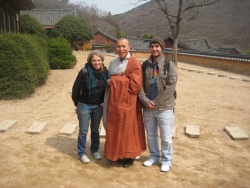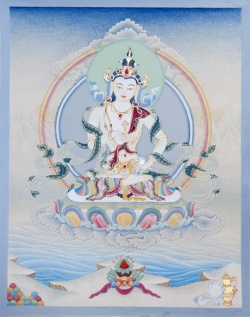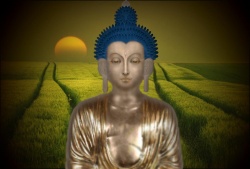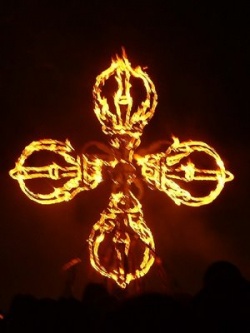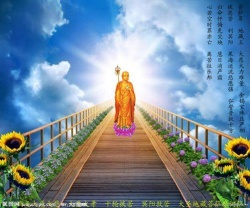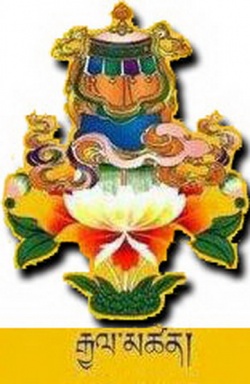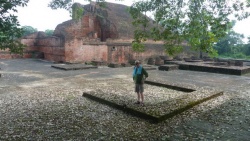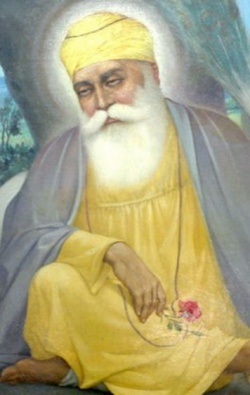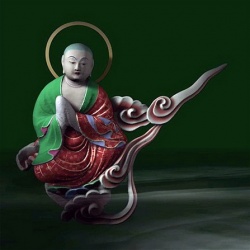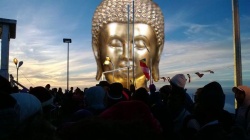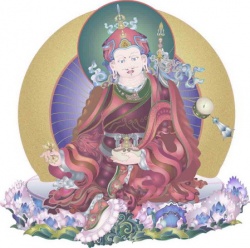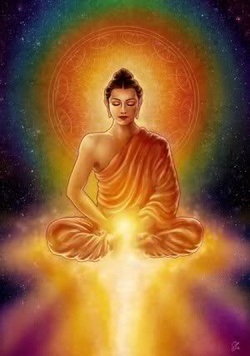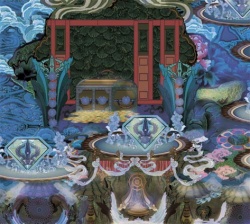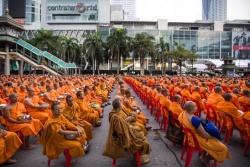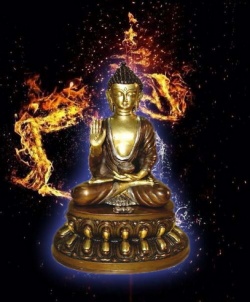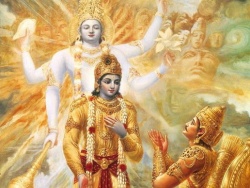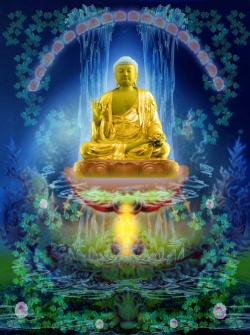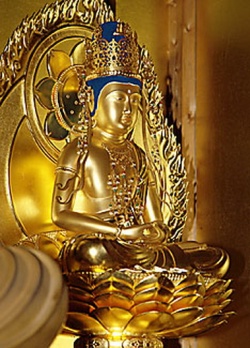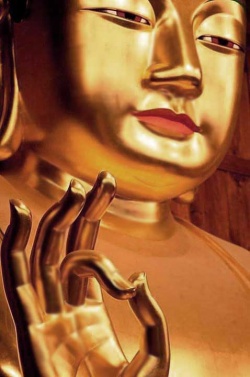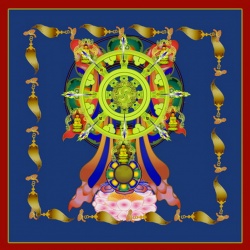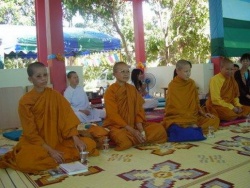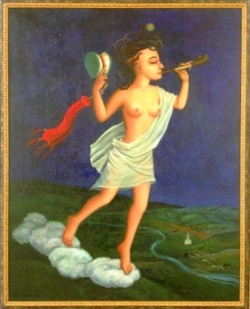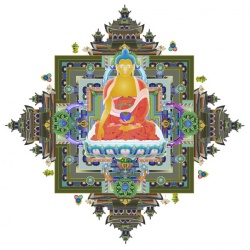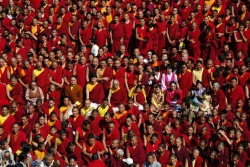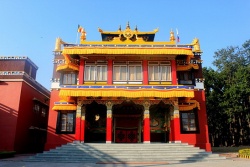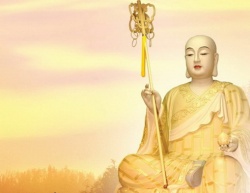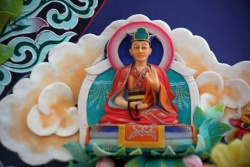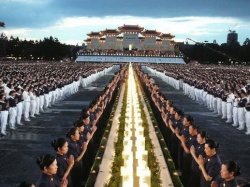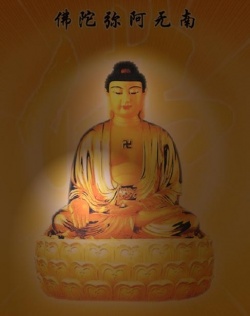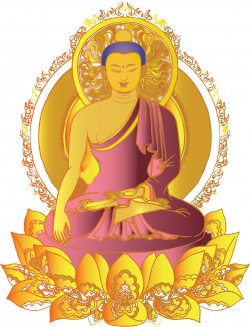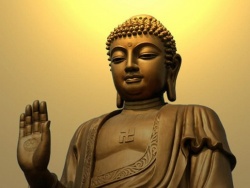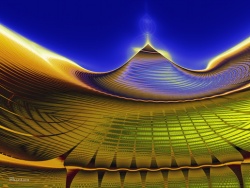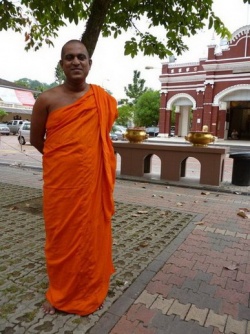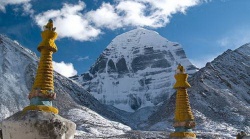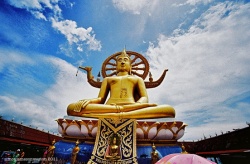A Preliminary to the Explanation of the Prajñaparamita
Nagarjuna
The great master Nagarjuna elucidated the aspect of emptiness, the direct teaching of the prajñaparamita, in the ‘Five-fold Collection of Madhyamika Reasoning’. These texts were written both to refute any true reality as something to be established, and to refute the logical reasonings that might establish it. With regard to the first, there is:
(1) the main body-like treatise, the Root Verses of the Middle Way
on Wisdom (Mulamadhyamaka-karika) that refutes groups from this (Buddhist) and other traditions.
Then there are the two subsidiary treatises derived from this:
(2) The Refutation of Objections, which is an expansion of the first section of the Fundamental Verses on ‘Examining Conditions’; and
(3) The Seventy Stanzas on Emptiness, which is an expansion of the seventh section of the Fundamental Verses on ‘Examining Arising, Dwelling and Ceasing’.
Then there are:
(4) Sixty Verses on Reasoning, which is a refutation of some within our own (Buddhist tradition in particular; and
(5) The Finely Woven, which is a refutation of the establishing logic known as the ‘sixteen words and meanings of the logicians.’
Thus there are five texts in the collection altogether.
Some followers of the older scholastic tradition in Tibet[2] added Conventional Existence to the other five, and some more recent scholars have added The Jewel Garland (Ratnavali). In this and other ways, they have asserted a ‘Six-fold Collection of Reasoning’, but as the Lord of Dharma Shyenpen pointed out:
“The Master Bhavaviveka said:
‘Through the texts known as The Fundamental Verses, Refutation of Objections,
Seventy Stanzas on Emptiness, Sixty-verse Reasoning
And The Finely Woven,
Things are established as beyond arising.’”
As he says, the number can certainly be put at five. And whilst the followers of the Gendenpa debate manuals count six by including The Jewel Garland, this was not the assertion of Jé Tsongkhapa himself, for he says in his Golden Rosary,[3] “You should understand that the belief in a fixed number of six texts in the Collection of Reasoning is erroneous.”
Discarding like hay the intent of Lobsang Drakpa,
The new Gelug works mislead the childish
With deceptive tricks of invention and false logic—
Who with an honest mind would deem them trustworthy?
ii. Dignaga
The Acharya Dignaga summarized the Eight Thousand Verse text into the thirty-two principle themes of the Mother Prajñaparamita.
He wrote:
Basis and that to be mastered,
Activity together with cultivation,
Division, sign and downfall,
Together with benefit—
These are perfectly expressed.
The basis is the teacher, the Lord Buddha (1).
That to be mastered is the assembly of bodhisattvas and shravakas
(2). The activity is how to engage in the prajñaparamita
(3). Cultivation refers to the ten antidotes to the ten uncritical and distracted concepts
(13). Division refers to the sixteen emptinesses
(29). Sign is the sign of not turning away from Mara
(30). Downfall is taking birth in the lower realms when abandoning the Prajñaparamita
(31). Benefit is the greater merit that is gained by such acts as writing out the Prajñaparamita, which surpasses an offering of the three-thousand-fold universe filled with the seven precious gems (32).
iii. The Author of Vanquishing Harm
The elaborate explanation of the vast and intermediate Mother Prajñaparamita texts and the 18,000 Verses in the commentary Vanquishing Harm explains the meaning of the Mother prajñaparamita by means of the three media and eleven categories.
The three media are:
1) The medium of the concise teaching for those who understand through stating the initial phrases;
2) The medium of the intermediate teaching for those who understand through slight elaboration; and
3) The medium of the elaborate explanation for those who are fond of words.
The eleven categories are the
(1) explanation granted to Shariputra;
(2) the elaborate explanation by Subhuti;
(3) the explanation granted to Shakra[4];
(4) Subhuti;
(5) Maitreya;
(6) Subhuti;
(7) Shakra;
(8) Subhuti;
(9) Maitreya;
(10) Subhuti; and
(11) Ananda.
This Vanquishing Harm is said in the old texts of past scholars to have been written by the Kashmiri Damstrasena. Some later scholars have claimed that there was some debate as to whether or not it was a commentary of Vasubandhu.
iv. Maitreya
In the Abhisamayalankara, the victorious Ajita[5] comments by combining the eight topics of the Mother Prajñaparamita with seventy points.
Conclusion
It is clear that when Dignaga comments on the sutras establishing the principal point to be expressed from the summary of the Eight Thousand Verses, the antidotes to the ten distracted concepts, it is done according to Distinguishing the Middle from Extremes, and the way he comments upon the sutras on the three essential natures[6] is according to The Mahayana Compendium. So he has not founded a tradition that is distinct from [what is already in] the treatises of Maitreya.
The commentary Vanquishing Harm too, by quoting from The Fundamental Verses on Wisdom in its ascertainment of emptiness and so on, remains in accordance with the intent of the Collection of Reasoning, and therefore cannot be thought of as initiating a separate tradition, distinct from that of Nagarjuna.
Therefore, in keeping with the assertion of Acharya Dharmamitra, the founders of the commentarial traditions of the Prajñaparamita, are certainly two in number:
1. Nagarjuna, who elucidated the stages of emptiness, the direct teaching of the Prajñaparamita Sutras; and
2. Maitreya, who elucidated the hidden meaning, the stages of manifest realization.
Generally, it is said that the founder of the tradition of the Profound Middle Way is the noble and sublime Nagarjuna and the founder of the tradition of Vast Conduct is the noble Asanga. There are also those who assert three founders in accordance with the Lord of Dharma Mipham Rinpoche who was really Mañjushri, and who, in his commentary to the Ornament of the Middle Way, added to these two the great Khenpo Shantarakshita as the founder of the tradition that united the Profound and the Vast. However, since these are the founders of the general traditions of the Mahayana, they should not be confused with the topic presently under discussion.
At that time, the word ‘founder’ [or literally charioteer’] means one who has been directly prophesied by the Buddha himself as a founder of a tradition, and who is accepted by his or her chosen deity, like the foremost of the bodhisattvas Maitreya or Mañjushri, and who comments on the intent of the victorious ones independently, without relying upon any other commentary of human authorship.
Abu Patrul Rinpoche, in his Trainings of the Buddhas’ Heirs,[7] follows the intent of the omniscient father and son[8] as found in such works as the great omniscient one’s root text and commentary to Mind in Comfort and Ease and the second omniscient one’s root text and commentary to The Treasury of Precious Qualities. [In this regard, he mentions] the lineage of Profound View originating with Nagarjuna; the lineage of Vast Conduct coming from Shantideva; and the lineage of the Vast and Profound in Unity which comes from Asanga and Vasubandhu, as well as the complete bringing together of these three lineage traditions, which is praised in the writings of the omniscient father and son, and which is a special lineage tradition for a way of practice that brings together all the various stages of practice found in the general Mahayana path, so that they are all included within the two types of precious bodhicitta. This is not to be confused with the general traditions, nor is there any conflict between them.
Generally, regarding the founders, there are also founders of the Hinayana traditions, and of the mantra traditions, so one cannot make a final and unequivocal decision that there were two or three.
It also appears that the Gelugpas recite in a particular prayer, “Tsongkhapa, founder of the tradition of the Land of Snows…” Despite featuring in their recitations, this assertion is not to be found in any commentary of profound meaning.
Lobsang Phuntsok in his Notes on the Expedient and Definitive said:
Based on statements from (Jé Tsongkhapa’s) Golden Rosary, such as “Jetsün (Maitreya) and Nagarjuna both…”, it appears one or two scholars have claimed that Maitreya was the founder of a tradition. Yet if this is asserted because Maitreya clearly reveals the hidden meaning [of the prajñaparamita) in the Abhisamayalankara, then since the Sutralankara and the two texts of ‘Distinguishing Clearly’ show the way of Mind Only, it would follow that Maitreya is also the founder of the Mind Only school. If one accepted that, then it would follow that Noble Asanga could not be [the founder of Mind Only), and one would be forced to assert something unaccepted by the majority of scholars.
So by committing the mistake of not distinguishing between the scriptural Mind Only and the philosophical school of Mind Only what appears like a logical consequence only obscures the intent of the Lord (Tsongkhapa), and it becomes rather like Jamyang Sakya Pandita’s statement:
Monkeys living in the forest,
Throwing muck at the trees.
Maitreya’s clear explication of the hidden meaning of the Prajñaparamita is proven by scripture and reasoning to be a new tradition of commentary unlike any before it.
As for the explanation in the style of Mind Only which features in the three intermediate works of Maitreya[9], called ‘scriptural Mind Only’, this was also explained in Nagarjuna’s Sixty-fold Reasoning, when he said:
The great elements and so on that are explained
Are perfectly subsumed within consciousness.
If one lacks that understanding
Is that not a mistaken analysis?
If one claims that the three intermediate works of Maitreya make clear the philosophical tenets of the Mind Only, then one should be able to identify which work amongst the three asserts an all-ground consciousness or a truly existent self-awareness. Since there is none, if you then say “It is so, because in our tradition we accept that these three intermediate works of Maitreya elucidate the tenets of Mind Only” then that is not a valid proof. It is rather like when those who believe in the sentience of trees say to the Buddhists, “Let us consider a tree, it must possess a mind, because its leaves curl up at night when it sleeps.”
The Sutras that the Abhisamayalankara Explains
Regarding the root sutras that are explained in the Abhisamayalankara, past writers have listed ‘seventeen mothers and sons’. There are said to be six ‘mother scriptures’ and eleven ‘son scriptures’.
As it says in the Thang-yig:
The Hundred Thousand, Twenty-five [Thousand],
Eighteen Thousand, Wisdom in Ten Thousand,
Eight Thousand and Condensed are the six ‘mothers’.
The Suvikrantavikrami-requested, Five Hundred Prajñaparamita,
Diamond-Cutter, One Hundred and Fifty Modes,
Kaushika-Requested, Thirty, Twenty-five Doors,
Heart of Wisdom, Few Letters,
Single Letter, Four Groups of Piled Gems,
And the Seven Hundred Verses of Transcendent Wisdom are the eleven ‘sons’.
The commentaries on the Prajñaparamita list the six ‘mothers’ just as they are given in the Thang-yig:
1) 100,000 Verses on Transcendent Wisdom (Shatasahasrika)
2) 25,000 Verses (Pañcavimshatisahasrika)
3) 18,000 Verses (Ashtadashasahasrika)
4) 10,000 Verses (Dashasahasrika)
5) 8,000 Verses (Ashtasahasrika)
6) Condensed (Samchaya)
The eleven ‘sons’ are:
1) 700 Verses on Transcendent Wisdom (Saptashatika)
2) 500 Verses (Pañcashatika)
3) 300 Verses (Trishatika)
4) 150 Modes (Naya shaia pañcashatika)
5) 50 Verses (Ardhashatika)
6) 25 Doors (Pañcavimshati)
7) Requested by Suvikrantavikrami
8) Requested by Kaushika
9) Few Letters of Transcendent Wisdom (Svalpakshara)
10) Single Letter of Transcendent Wisdom (Ekashari)
11) The Heart of Wisdom (Prajñahridaya)
Regarding the criteria for classifying these as either ‘mother’ or ‘son’ scriptures, sutras revealing the eight manifest realizations are termed ‘mother’ scriptures, whilst those revealing them only partially are termed ‘son’.
As for the objection raised by some later scholars[10] who dispute this enumeration of seventeen ‘mothers’ and ‘sons’, it is tantamount to opposing the Buddha himself, for it is stated in The Sutra Requested by Kaushika:
The Bhagavan remained on Vulture Peak Mountain, on the occasion of completing the seventeen ‘mothers’ and ‘sons’ of the Prajñaparamita.
When refuted by this quotation, to then object that this sutra was not taught by the Buddha is a deprecation reminiscent of the Chinese scholar Hva-shang taking whichever sutras contradicted his own position and rolling them under his feet— besides amassing the severe karma of rejecting the Dharma, there can be no valid reason for it. There is absolutely no logical flaw in applying the convention of seventeen ‘mother’ and ‘son’ scriptures. If one applies the name ‘seventeen mother and son scriptures’ to group together seventeen prajñaparamita sutras taught together by the Buddha, this does not imply that he did not teach any other prajñaparamita sutras.
It might be said, “It is unreasonable to fix the number of prajñaparamita sutras at seventeen, because this has the fault of being too few, since it omits such sutras as The Heart of the Sun Prajñaparamita, The Heart of the Moon, The Sutra Requested by Samantabhadra, The Sutra Requested by Vajrapani and The Sutra Requested by Vajraketu[11], and also has the fault of being too many because The Condensed Sutra is actually one chapter of the 18,000 Verse text, and if that is to be counted separately so should the other chapters.” Although this appears logical, it would follow that it is equally unreasonable for you to fix the number of prajñaparamita sutras at three, i.e. vast, intermediate and condensed, since this too would not include [all the prajñaparamita sutras), and you yourselves have already accepted this line of reasoning.
Then you might say, “We are not saying definitively that there are no other prajñaparamita sutras in general besides these three, but we are counting these three as the main prajñaparamita sutras amongst the principal sutras explained in the Abhisamayalankara, so there is no fault.” But this is just the same as when those [who assert seventeen mother and son scriptures) say that they do not claim these seventeen to be the only prajñaparamita sutras, but the seventeen principal sutras explained in the Abhisamayalankara.
It is indeed true that The Condensed Sutra is a single chapter of the 18,000 Verse text, but it is not necessarily equal to the other chapters. One should perhaps consider why there are three commentaries that connect the Abhisamayalankara with The Condensed Sutra, but none that connect the Abhisamayalankara with any other chapter. To consider that they are equal in what they express simply because they are similar in being chapters is the sort of thinking that leads one to believe a fox and a lion are the same since they are both equal in being wild creatures, or that a thought and a vase are the same since they are both knowable phenomena!
One should not think, “The sutras explained in the Abhisamayalankara must be just the vast, intermediate and condensed sutras, and it is unacceptable to state this about any other of the seventeen mother and son scriptures because that would conflict with the Clarifying the Meaning commentary [by Haribhadra).” Statements in Clarifying the Meaning such as “The ornament of all” and “The discovery of treatises like this is wondrous indeed!”, can only mean that the sublime Abhisamayalankara is made more sublime by being the ornament of all the Mother Prajñaparamitas, and that apart from increasing its value it does not constitute any defect whatsoever.
One should reflect carefully why, if it is especially sublime since it is understood as the ornament of the main three prajñaparamita sutras, it should not be made more sublime by being understood as the ornament of the main seventeen prajñaparamita sutras.
Therefore, the main basic sutras that are explained in the Abhisamayalankara are the six ‘mother’ scriptures because they are the sutras to which the subject matter of the Abhisamayalankara, i.e. the stages of manifest realization, can be applied. This is clear from the presence of actual Indian commentaries that combine the Abhisamayalankara with the 100,000 Verses, the 25,000 Verses, the 8,000 Verses and The Condensed Sutra. In his Overview of the Prajñaparamita, the gentle-voiced Abu (Patrul Rinpoche) makes the point that because The Condensed Sutra is combined, the 18,000 Verses is also combined indirectly, and it is evident that the 10,000 Verse Prajñaparamita text is also suitable for combination—and that is just how it is. Therefore, the eleven ‘son’ scriptures and so on are ordinary sutras that are explained.
In short, whether one considers the sutras explained in the Abhisamayalankara to be the vast, intermediate and condensed sutras or the seventeen ‘mother’ and ‘son’ scriptures, it is indeed true that these can not be said with certainty to be the only prajñaparamita sutras in general, or the only sutras explained in the Abhisamayalamkara in particular. I do not think there is any contradiction in such claims.
The Twenty-one Indian Commentaries
There are twelve commentaries which combine sutras with the Abhisamayalankara, and nine which do not. Among the former group, four use the 25,000 Verses, three use the 8,000 Verse text, three use The Condensed Sutra, one uses the 100,000 Verses, and one uses the three texts of the 100,000 Verses, the 25,000 and the 8,000.
Firstly, the four are:
1) Arya Vimuktisena’s Illuminating the 25,000 Verses
2) Bhadanta[12] Vimuktisena’s Commentary on the 25,000
3) Acharya Haribhadra’s Eight Chapters on the 25,000
4) Ratnakarashanti’s Pure 25,000 (Shuddhimati)
Secondly, the three are:
1) Acharya Haribhadra’s Light Ornament: A Great Commentary on the 8,000 Verses]]
2) Ratnakarashanti’s Supreme Essence (Sarottama)
3) Abhayakaragupta’s Moonlight of Points (Marmakaumudi)
Thirdly, the three are:
1) Acharya Haribhadra’s Easy-to-Comprehend Commentary on the Difficult Points of the Condensed Sutra
2) Buddhashrijñana’s Commentary on the Difficult Points of the Condensed Sutra
3) Kashmiri Dharmashri’s Key to the Treasury of Transcendent Wisdom
Fourthly, there is:
1) Explanation of the 100,000 said to be by Kashmiri Dharmashri.
Fifthly:
1) Teaching on the Three Renowned ‘Mother’ Scriptures in Conformity with the Eight Points said to be by Lord Smritijñanakirti.
Secondly, there are the nine which do not connect [the Abhisamayalankara) with sutras:
1) Acharya Haribhadra’s Commentary Clarifying the Meaning[13]
2) Dharmamitra’s Explanatory Commentary Clarifying the Words
3) Suvarnadvipa’s Light on the Difficult-to-Comprehend
4) 5) and 6) Prajñakaramati’s, Jowo Atisha’s and Kumarashribhadra’s Three Essential Meanings
7) Ratnakirti’s Kirtikala
8) Kashmiri Buddhashrijñana’s Rosary of Liberating Wisdom
9) Abhayakaragupta’s Ornament of the Sage’s Realization
Among these, The Explanatory Commentary Clarifying the Words, Light on the Difficult-to-Comprehend, and Prajñakaramati’s Essential Meaning are commentaries on (Haribhadra’s) Commentary Clarifying the Meaning.
It is explained in Drukpa Pema Karpo’s commentary on the prajñaparamita that Haribhadra and Prajñakaramati both saw Maitreya directly, and that Dharmamitra saw him in a dream.
Some assert that The Ascertainment of Suchness written by Noble Asanga is a commentary that combines sutra and Abhisamayalankara, and some even say that the Commentary Clarifying the Meaning is a commentary combining sutra and Abhisamayalankara. This would mean that the number of commentaries combining sutras and Abhisamayalankara could not be fixed definitively at twelve, but since this would contradict what is generally accepted, it requires investigation. Scholars may take as an issue for further investigation the question of whether Kashmiri Buddhashri’s 100,000 Verse Commentary, Smritijñanakirti’s work on the Three Mother Scriptures in Comformity with the Eight Points, and Atisha’s Lamp of Essential Meaning are to be classified as the works of Indian Panditas or Tibetan Scholars.
Concerning which of those amongst these commentaries are particularly sublime, the great learned and accomplished Prajñarasmi said:
The progressive path from the hidden meaning of the middle turning,
Was elucidated by the Dharma Lord Ajita in Tushita.
In the Noble Land [of India) there were six transmissions
And many ways of commenting upon the intent of the Ornament,
But those commentaries of Arya (Vimuktisena) and Haribhadra are especially sublime.
Just as he says, one should rely mainly upon the commentaries of Vimuktisena and Haribhadra.
Works of the Ancient Translation School
The great omniscient Mahapandita Shyenpen Chökyi Nangwa’s filling-in commentary (mchan ‘grel) on The Commentary Clarifying the Meaning also makes reference to Dharmamitra’s Explanatory Commentary Clarifying the Words, and Suvarnadvipa’s Light on the Difficult-to-Comprehend, as well as Acharya Haribhadra’s Light Ornament, Ratnakarashanti’s Pure 20,000 and others. It does not spoil the intent of the Indian commentaries and is unadulterated by even the slightest assertion from a Tibetan scholar. The tradition of expounding this has been maintained and developed by successive khenpos at the seat of the great and accomplished Lord of Dokham—Dzogchen—where it has not declined even to this day.
The second throne-holder of Mindroling Pema Gyurme Gyatso wrote an overview of the Commentary Clarifying the Meaning called The Heart-Juice of Nectar that accords with the commentary of the great Sakya scholar Rongtön. This fits with the saying of many early scholars that:
The Vinaya has reached Tso,[14]
The Abhidharma has reached Chim,[15]
The Madhyamaka has reached Re[ndawa],[16]
The Prajñaparamita has reached Yak.[17]
The Dharma Lord Patrul Rinpoche composed an Overview of the Prajñaparamita, a Word-by-word Commentary and Progressive Stages of Meditation, which accord with the Golden Rosary commentary of the great Jetsün Tsongkhapa. Regarding the use of Jetsün Tsongkhapa’s commentary as a basis, the great Dzogchen khenpos always used to say that since this was [actually] Omniscient Longchenpa’s Prajñaparamita commentary, it remains purely an explication of the Ancient Translations school.
Jamyang Mipham Rinpoche composed a commentary on The Condensed Sutra which takes the Ancient Translations tradition as its basis, an application of the Abhisamayalankara to The Condensed Sutra, and a commentary on the Abhisamayalankara. The commentary of his follower, the supremely learned Böpa Tulku[18], is now being spread by his own students.
I have spoken at length here so as to inspire confidence in those newcomers [to this tradition).
In short, the pure explanations of the Ancient Translation school belong to the scriptural tradition of the Six Ornaments and Two Supreme Ones[19], together with their followers. These are the scriptures that were established in the past through translation, explanation and study by the lotsawas and panditas of India and Tibet during the era of Khenpo Shantarakshita, Acharya Padmasambhava and Dharma-king Trisong Detsen. At that time, these same works were taught and studied by those who began the thirteen great centres of learning, such as the study college (shedra) at the glorious Samye. This also refers to the works composed by the two victorious ones, Rongzom and Longchenpa, in addition to those of the omniscient Jamyang Mipham in this tradition of the Nyingma.
Therefore, for the Nyingmapas themselves to feel that their assertions must be quite unlike those of anyone else, or for others to consider them as incompatible with any other system is simply to flaunt the signs of one’s own misunderstanding, and is not even worthy of investigation. So whether one belongs to this tradition or another, one should feel wary about accumulating the karma of rejecting the Dharma, by following after unsubstantiated claims, which are like the warning cries of the rabbit in the well-known story. Nevertheless, this is not the time for me to explain the many profound qualities of the special instructions of the Kama, Terma and Pure Vision traditions of secret mantra.
This was a preliminary to the teaching and study of the Ornament,
Identifying the founders of traditions based on the prajñaparamita sutras,
Which sutras are explained in the Abhisamayalankara,
And the Ornament’s Indian commentaries.
By Virya.[20]
Composed by the first Khenpo at the Ngagyur Nyingma Institute’s centre for the study of sutra and mantra, Khen Rinpoche Thubten Tsöndru.
Virtue!
translated by Adam Pearcey
© Adam Pearcey 2004.
[1] Believed to be Damstrasena, see below.
[2] This mainly refers to Butön Rinchen Drup (1290-1364).
[3] The Golden Rosary of Excellent Explanation (legs bshad ser phreng) is Jé Tsongkhapa’s commentary on the Abhisamayalankara.
[4] Indra
[5] Another name for Maitreya
[6] Tib. ngo bo nyid gsum, i.e., the imputed, dependent and fully established.
[7] rgyal ba’i sras kyi bslab bya mdor bsdus nyams len snying po Collected works vol II pp. 571-585
[8] Longchen Rabjam and Jikmé Lingpa.
[9] i.e. Sutralamkara, Madhyantavibhanga and Dharmadharmatavibhanga
[10] i.e. Jé Tsongkhapa and the Gelug school
[11] See E.Conze’s Prajñaparamita Literature p.84
[12] Bhadanta Vimuktisena (btsun pa rnam grol sde) was a student of Arya Vimuktisena (‘phags pa rnam grol sde)
[13] This has become the most celebrated of the Indian commentaries.
[14] Kunkhyen Tsonawa Sherab Zangpo
[15] Chim Jampeyang
[16] Rendawa Shyönnu Lodrö
[17] i.e., Yak-Rong – Yaktruk Sangye Pal and Rangtön Sheja Kunzik of the Sakya school.
[18] The great master ]]Böpa Tulku]] (d.1959), who was a student of Khenpo Kunpal, is said to have written two commentaries on the Abhisamayalankara, called The Words of the Invincible Maitreya (Ma pham zhal lung) and Ornament for the Enlightened Vision of the Invincible Maitreya (Ma pham dgongs rgyan), but only the former is known to have survived.
[19] The Six Ornaments are Nagarjuna, Aryadeva, Asanga, Vasubandhu, Dignaga and Dharmakirti. The Two Supreme Ones are Shakyaprabha and Gunaprabha.
[20] Virya is the Sanskrit for Tsöndru.
